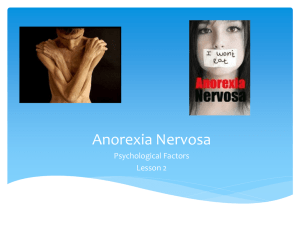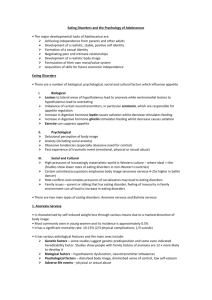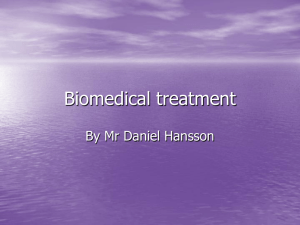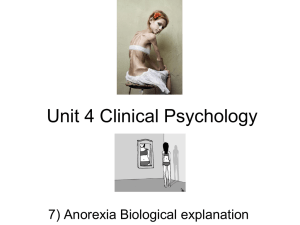Chapter 33 The Child with an Emotional or Behavioral Condition
advertisement
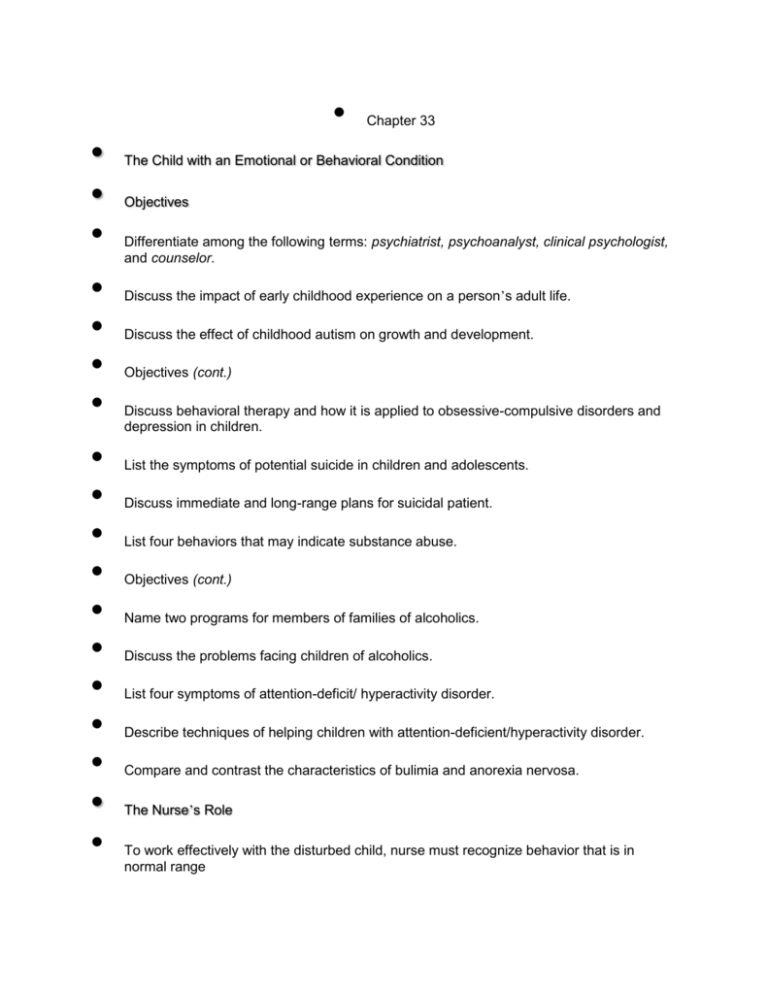
• • • • • • • • • • • • • • • • • • • Chapter 33 The Child with an Emotional or Behavioral Condition Objectives Differentiate among the following terms: psychiatrist, psychoanalyst, clinical psychologist, and counselor. Discuss the impact of early childhood experience on a person’s adult life. Discuss the effect of childhood autism on growth and development. Objectives (cont.) Discuss behavioral therapy and how it is applied to obsessive-compulsive disorders and depression in children. List the symptoms of potential suicide in children and adolescents. Discuss immediate and long-range plans for suicidal patient. List four behaviors that may indicate substance abuse. Objectives (cont.) Name two programs for members of families of alcoholics. Discuss the problems facing children of alcoholics. List four symptoms of attention-deficit/ hyperactivity disorder. Describe techniques of helping children with attention-deficient/hyperactivity disorder. Compare and contrast the characteristics of bulimia and anorexia nervosa. The Nurse’s Role To work effectively with the disturbed child, nurse must recognize behavior that is in normal range • • • • • • • • • • • • • Keep accurate documentation of behaviors and note relationships or interactions with the patient and members of the family Multidisciplinary Services National Alliance for Mentally Ill (NAMI) Family Services Association of America, Inc. Tough Love Youth Suicide, National Center Nursing Tips Parents provide important assessment data about the child that the young child cannot provide They are also important in bringing the child to therapy Discrediting parents threatens the child and is not therapeutic Health Care Staff Basic staff – – – – – – – Psychiatrist Psychologist Clinical psychologist Counselor Social worker Pediatrician Nurse Types of Interventions • • • • • • • • • • • • • • Individual Family therapy Behavior modification Milieu therapy Art therapy Play therapy Recreation therapy Bibliotherapy Origins of Emotional and Behavioral Conditions Dysfunctional families can have long-lasting impact on the child – – – – Failure to develop sense of trust Excessive fears Misdirected anger Feelings of lack of control over themselves and their environment • • May feel negative about themselves May experience guilt and blame themselves when confronted with disappointment and failure Organic Behavioral Disorders Childhood Autism May be due to autosomal recessive inheritance Signs and symptoms – Lack of pointing or gesturing at an early age • • • • • • • • • • • • • • • – – – – Failure to make eye contact/look at others Poor attention Poor response to name Repetitive behaviors are significant signs of dysfunction by 1 year of age Requires highly structured environment Use one request at a time Obsessive-Compulsive Disorders in Children Involves a recurrent, persistent, repetitive thought that invades the conscious mind (obsession) or ritual movement or activity (not related to adapting to the environment) that assumes inordinate importance (compulsion) Obsessive-Compulsive Disorders in Children (cont.) May be related to depression May start as early as 4 years of age and progress to interfering with daily functioning until 10 years of age or older No impairment in cognitive function Genetic origin Can involve family problems Treatment is behavior therapy and medication Environmental or Biochemical Behavioral Disorders Depression A prolonged behavioral change from baseline that interferes with school, family life, or age-specific activities Difficult to diagnose in children • • • • • • • • • Can lead to substance abuse if left untreated Depression (cont.) Young children Symptoms can include – – – – – Head banging Truancy Lying Stealing If left untreated, can lead to substance abuse and/or suicide School-age children Symptoms can include – – – – – Loss of appetite Sleep problems Lethargy Social withdrawal Sudden drop in grades Depression (cont.) Nursing responsibilities – – – Recognizing the signs Initiating referrals Educating parents and school personnel concerning the identification of children at risk Treatment – Medication – • • • • • • • • • Outpatient counseling Suicide Leading cause of death in adolescence, after accidents and homicide – – Completed suicides more common with boys Attempted suicides more common with girls Risk of successful suicide increases when – – – – There is a plan of action A means to carry out the plan An absence of obvious resources to turn to for help Low self-esteem or frustrations turn hostilities inward Suicide (cont.) Suicidal ideation – Thoughts of suicide Suicidal gestures – An attempt at suicidal action that does not result in injury Suicidal attempt – – An action that is seriously intended to cause death Can be impulsive act or chronic behavior Suicide (cont.) Nurse’s role – Education • • • • • • • • • – – – Prevention Identification of those children at risk Prompt referral for follow-up care Nursing Tip When an adolescent feels hopeless and talks about feeling useless or worthless, do not contradict what he or she is saying Instead listen, indicate your understanding, and encourage the expression of feelings Substance Abuse Illegal use of drugs, alcohol, or tobacco for the purpose of achieving an altered state of consciousness Substances can be – – – Ingested Injected Inhaled Substance Abuse (cont.) Four levels – – – – Experimentation Controlled use Abuse Dependence • • Psychological Physical Substance Abuse (cont.) • • Two types of dependence – Substances that are used/abused – – • • • • • Psychological and physical Alcohol • Experimentation has traditionally been accepted as a normal part of growing up Cocaine (“crack”) • • Can be snorted, smoked, or injected into a vein Can cause antisocial behavior or life-threatening response Substance Abuse (cont.) Gateway substances (lead to abuse of stronger drugs) – Common household products cause euphoria (high) and then CNS depression • • • • • Cleaning fluid Glue Lighter fluid Paints Shoe polish Substance Abuse (cont.) Marijuana (hemp plant) – Smoked or ingested Causes the person to experience – – – Loss of inhibitions Euphoria Loss of coordination and direction • • • • • • • • • • Substance Abuse (cont.) Opiates – Heroin Users are at risk for – – HIV Hepatitis Long-term therapy is required Substance Abuse (cont.) Prevention and nursing goals – – – – Teach parenting skills to expectant parents Develop positive self-image and feelings of self-worth Provide positive role models Develop coping skills regarding substance abuse Substance Abuse (cont.) Children of alcoholics Support groups available – – Al-Anon (for adolescents) Alcoholics Anonymous (AA—for adults) Child confused by unpredictability of family life – – Their needs are not being met May take role of parent • • • • • • • • • – – May be isolated from peers Role models distorted or lacking Children of Alcoholics Children of Alcoholics (cont.) Clues – – – – – – Refusal to talk about family life Poor grades or overachievement Unusual need to please Fatigue Passive or acting-out behavior Maturity beyond the child’s years Attention Deficit Hyperactivity Disorder (ADHD) An inappropriate degree of gross motor activity, impulsivity, and inattention in school or home setting that begins before age 7 years, lasts more than 6 months, and is not related to the existence of any other central nervous system illness Characterized by inattention, hyperactivity, impulsivity, and distractibility May be genetic Attention Deficit Hyperactivity Disorder (ADHD) (cont.) DSM-IV-TR lists criteria for ADHD – – May have above-average intelligence Problem may be • • Receptive language Expressive language • • • • • • • • • • • • • • Information processing Memory Motor coordination Orientation Behavior Attention Deficit Hyperactivity Disorder (ADHD) (cont.) Screening tools can enable early intervention – Such as “Einstein Evaluation of School-Related Skills” May have – – – Dyslexia Dysgraphia Problem expressing themselves Anorexia Nervosa A form of self-starvation seen mostly in adolescent girls Anorexia Nervosa (cont.) Criteria according to the DSM-IV-TR – – – – Failure to maintain the minimum normal weight for age and height An intense fear of gaining weight Excess influence of body weight on self-evaluation Amenorrhea Anorexia Nervosa (cont.) May be genetic • • • • • • Characteristics – – – – – Average to superior intelligence Overachievers who expect to be perfect in all areas Threatened by their emerging sexuality Obedient Nonassertive and shy Have a low self-esteem Anorexia Nervosa (cont.) On physical examination may find – – – – – – – Dry skin Amenorrhea Lanugo hair over the back and extremities Cold intolerance Low blood pressure Abdominal pain Constipation Anorexia Nervosa (cont.) Adolescent experiences – – – – Feelings of helplessness Lack of control Low self-esteem Depression • • • • • • • • • • Socialization with peers diminishes Mealtimes are a battleground Body image becomes increasingly disturbed Lack of self-identity Anorexia Nervosa (cont.) Treatment – – – – – May require hospitalization Electrolyte imbalance Establish minimum restoration of nutrients Stabilize weight Therapy • • Individual and family Medications Anorexia Nervosa (cont.) Prognosis – Gaining weight while in hospital is not a good predictor of future success Complications include – – – – – Gastritis Cardiac arrhythmias Inflammation of the intestines Kidney problems Death Bulimia • • • • • • • • • • • • DSM-IV-TR lists characteristics as – – – Recurrent episodes of uncontrolled binge eating followed by self-induced vomiting and the misuse of laxatives and/or diuretics Family dysfunction usually present Mother-daughter relationship usually distant or strained Bulimia (cont.) Binge-purge cycle thought to be a coping mechanism for dealing with guilt, depression, and low self-esteem Impulsive behaviors also characteristic Persistent vomiting causes erosion of tooth enamel Use of laxatives and vomiting can cause electrolyte imbalance Bulimia (cont.) Nursing role – – – – Educate Prevent Identify Refer Minimizing the Impact of Behavioral Disorders in Children Once the source of the problem is identified, a combination of mental health interventions can be implemented or the child can be referred as needed Effect of the Illness on Growth and Development Duration and intensity of a stressful event and the child’s coping skills determine the impact on the growth and development process • • • • • • • • • • • • • • • • • • Requires a total family approach to care A knowledgeable, caring, understanding, and supportive nature is valuable for any nurse caring for children with behavioral disorders Effect of the Illness on Siblings Most siblings of children with emotional disorders either suffer emotional scars or develop protective coping mechanisms to deal with their experiences If long-term, the siblings are at risk for developing low self-esteem and problems with their own peer relationships Sibling Rivalry A competition between siblings for the attention or love of parents Is a normal part of growth and development Can cause guilt on the part of the sibling who is not ill Teaches interactive social skills that will be used with friends Question for Review What is the difference between the eating disorders of anorexia nervosa and bulimia? Review Objectives Key Terms Key Points Online Resources Review Questions




